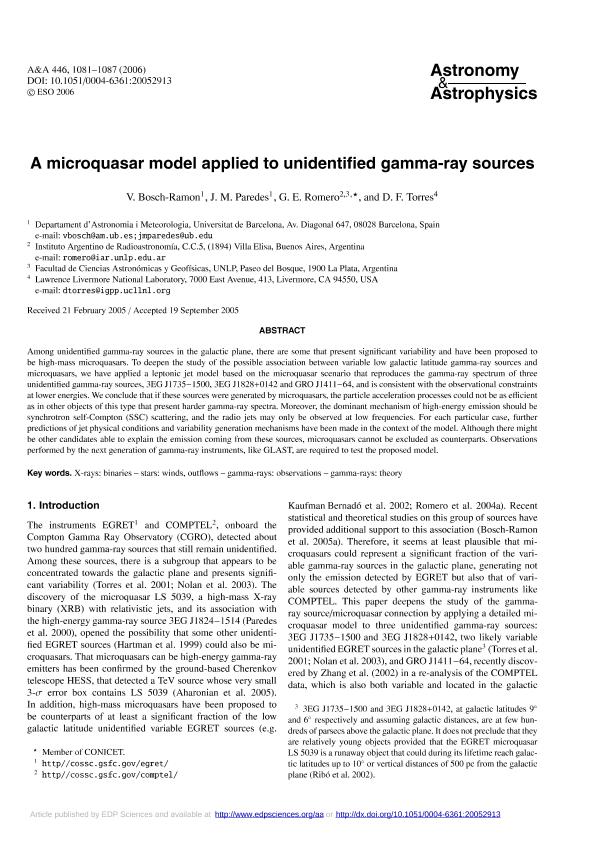Mostrar el registro sencillo del ítem
dc.contributor.author
Bosch Ramon, Valentí

dc.contributor.author
Paredes, Josep Maria

dc.contributor.author
Romero, Gustavo Esteban

dc.contributor.author
Torres, Diego F.

dc.date.available
2017-08-14T18:57:26Z
dc.date.issued
2006-12
dc.identifier.citation
Bosch Ramon, Valentí; Paredes, Josep Maria; Romero, Gustavo Esteban; Torres, Diego F.; A microquasar model applied to unidentified gamma-ray sources; Edp Sciences; Astronomy And Astrophysics; 446; 12-2006; 1081-1087
dc.identifier.issn
0004-6361
dc.identifier.uri
http://hdl.handle.net/11336/22318
dc.description.abstract
Among unidentified gamma-ray sources in the galactic plane, there are some that present significant variability and have been proposed to be high-mass microquasars. To deepen the study of the possible association between variable low galactic latitude gamma-ray sources and microquasars, we have applied a leptonic jet model based on the microquasar scenario that reproduces the gamma-ray spectrum of three unidentified gamma-ray sources, 3EG J1735-1500, 3EG J1828+0142 and GRO J1411-64, and is consistent with the observational constraints at lower energies. We conclude that if these sources were generated by microquasars, the particle acceleration processes could not be as efficient as in other objects of this type that present harder gamma-ray spectra. Moreover, the dominant mechanism of high-energy emission should be synchrotron self-Compton (SSC) scattering, and the radio jets may only be observed at low frequencies. For each particular case, further predictions of jet physical conditions and variability generation mechanisms have been made in the context of the model. Although there might be other candidates able to explain the emission coming from these sources, microquasars cannot be excluded as counterparts. Observations performed by the next generation of gamma-ray instruments, like GLAST, are required to test the proposed model.
dc.format
application/pdf
dc.language.iso
eng
dc.publisher
Edp Sciences

dc.rights
info:eu-repo/semantics/openAccess
dc.rights.uri
https://creativecommons.org/licenses/by-nc-sa/2.5/ar/
dc.subject
X Ray Binaries
dc.subject
Star Winds
dc.subject
Outflows
dc.subject
Gamma Ray Observations
dc.subject
Gamma Rays
dc.subject.classification
Otras Ciencias Físicas

dc.subject.classification
Ciencias Físicas

dc.subject.classification
CIENCIAS NATURALES Y EXACTAS

dc.title
A microquasar model applied to unidentified gamma-ray sources
dc.type
info:eu-repo/semantics/article
dc.type
info:ar-repo/semantics/artículo
dc.type
info:eu-repo/semantics/publishedVersion
dc.date.updated
2017-05-18T21:20:13Z
dc.journal.volume
446
dc.journal.pagination
1081-1087
dc.journal.pais
Francia

dc.journal.ciudad
Les Ulis Cedex A
dc.description.fil
Fil: Bosch Ramon, Valentí. Universidad de Barcelona; España
dc.description.fil
Fil: Paredes, Josep Maria. Universidad de Barcelona; España
dc.description.fil
Fil: Romero, Gustavo Esteban. Provincia de Buenos Aires. Gobernación. Comision de Investigaciones Científicas. Instituto Argentino de Radioastronomía. Consejo Nacional de Investigaciones Científicas y Técnicas. Centro Científico Tecnológico Conicet - La Plata. Instituto Argentino de Radioastronomia; Argentina. Universidad Nacional de la Plata. Facultad de Ciencias Astronómicas y Geofísicas; Argentina
dc.description.fil
Fil: Torres, Diego F.. Lawrence Livermore National Laboratory; Estados Unidos
dc.journal.title
Astronomy And Astrophysics

dc.relation.alternativeid
info:eu-repo/semantics/altIdentifier/doi/http://dx.doi.org/10.1051/0004-6361:20052913
dc.relation.alternativeid
info:eu-repo/semantics/altIdentifier/url/https://www.aanda.org/articles/aa/abs/2006/06/aa2913-05/aa2913-05.html
Archivos asociados
